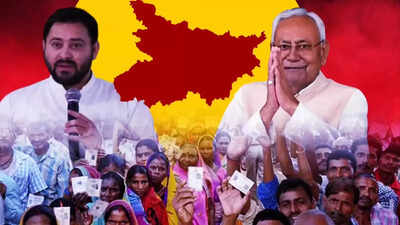Bihar has delievered its verdict. It’s NDA ‘phir ek baar, with 200 paar’. They’re poised to break the 2010 record, when the NDA won 206 seats. The results have given both stunning victories and crushing setbacks. Here’s a look at the biggest winners and losers of Bihar’s high-stakes 2025 election.WINNERS1. Nitish KumarJanata Dal (United) chief Nitish Kumar has once again emerged as the biggest winner of the Bihar elections 2025 as he managed to fight the 20 years of anti-incumbency and voter fatigue effectively. Despite nearly two decades in power, Nitish’s JD(U) made a clear gain this elections while leading in over 80 seats with the NDA tally of over 200 in the 243-member assembly.
Election Results 2025
With this, Nitish has also blocked Tejashwi Yadav’s rise (again). Tejashwi had strong momentum in the last election with the RJD emerging as the largest single party and hoped for a full-term run this time. But the results show that the “youth vs experience” narrative has collapsed in Nitish’s favour.2. PM ModiThe Bihar election results have once again proved that Prime Minister Narendra Modi it the GOAT with the NDA’s performance resting heavily on his personal popularity. Despite local anti-incumbency against Nitish Kumar, voters seems to have clearly distinguished state issues from PM Modi’s national leadership and voted in favour of “Modi ki guarantee”. His welfare schemes clearly created a strong beneficiary base that rallied behind the NDA. The results also halt any opposition momentum and reaffirm PM Modi’s unmatched vote-transferability, keeping the BJP firmly positioned for 2029. His BJP emerged as the single largest party by winning 89 seats. In a state defined by caste and shifting alliances, Bihar shows that PM Modi’s appeal still drives the coalition’s success.Chirag PaswanChirag Paswan has emerged as one of the biggest gainers this Bihar election, marking a sharp turnaround from 2020 when his LJP won just one seat despite securing nearly 6% vote share. This time, his party has converted that scattered support into solid gains by winning 22 seats out of the 29 seats it was contesting.This result proves that Chirag’s personal appeal worked among Dalits and “yuva Biharis”. By distancing himself from the Nitish Kumar-led NDA earlier and then returning as a strengthened ally, he positioned himself as a rising force with independent bargaining power. His improved tally signals the consolidation of the Paswan vote and elevates him from a fringe disruptor in 2020 to a key power player in 2025.Women voters Women were the biggest winners of the Bihar elections, driving historic turnout and decisively shaping the verdict. For the first time, women outvoted men, 72% versus 63%, with many districts seeing a 10–20 point lead in female turnout. Their overwhelming participation tilted the mandate toward the NDA, boosted by welfare schemes like the Rs 10,000 Mukhyamantri Mahila Rozgar Yojana, which resonated with poorer and backward communities. Years of empowerment through panchayati raj reservations and Jeevika self-help groups strengthened mobilisation. Prioritising governance, safety and stability, women voters backed parties promising welfare and security, becoming the true kingmakers of Bihar 2025.Asaduddin Owaisi Owaisi’s AIMIM may not have won a large number of seats in the 2025 Bihar election, but politically, Owaisi walks away as a clear strategic winner. AIMIM was leading in five seats as counting was under way for the Bihar assembly polls, according to the Election Commission.The party, which has significant influence in the Seemanchal region that has a high Muslim population, is contesting 29 of the 243 seats in the assembly. Twenty-four of the seats it is contesting are in the Seemanchal region.His party once again proved its ability to shape tight contests in Muslim-heavy constituencies across Seemanchal, reaffirming his relevance in a state where every percentage point matters.LosersTejashwi YadavThe Bihar election result marks a major setback for Tejashwi Yadav, who entered the race as the opposition’s CM face and the Mahagathbandhan’s only realistic challenger to the NDA. After leading RJD to 75 seats in 2020, making it the single largest party, Tejashwi was widely expected to build on that momentum in 2025. Instead, Tejashwi failed to convert the momentum and inti-incumbancy wave against Nitish Kumar into actual votes. His party is leading on only 29 seats.This would be RJD’s second-worst showing in Bihar election after 2010 polls when theparty had won only 22 seats. This election was a test of whether Tejashwi could break out of RJD’s traditional Muslim–Yadav base and appeal to new generation of voters looking for governance-focused leadership. Despite energetic campaigning and a sharp message against Nitish, the party’s vote share did not see the substantial jump needed to tilt the state’s arithmetic. Most damaging for Tejashwi is the narrative loss. The 2020 result had established him as the emerging face of Bihar politics. This time, however, instead of expanding his political footprint, Tejashwi finds himself stalled and for a leader who hoped to become Bihar’s next CM, that makes him the biggest loser of this election.Rahul GandhiThe Bihar election has dealt a significant blow to Rahul Gandhi, whose Congress once again failed to make any significant gains in the state and was reduced to single digit. Despite efforts from Rahul Gandhi to revive the party’s fortunes in Bihar, which included a series of high-profile campaigns like the “vote chori” allegations against the Centre and the Election Commission, the Special Intensive Revision in Bihar, and the Voter Adhikar Yatra, Congress has failed to make a substantial impact. Although these issues were intended to galvanise voter support, they appear to have fallen flat in comparison to the local issues that resonate more strongly with Bihar’s electorate.In 2020, Congress had contested 70 seats as part of the Mahagathbandhan and won just 19, pulling down the alliance’s overall tally despite Tejashwi Yadav’s strong performance. This election offered an opportunity to correct that trajectory but Congress failed to improve its footprint, reinforcing the perception that it adds little electoral value in key Hindi heartland contests. Prashant KishorPrashant Kishor, once hailed as India’s top election strategist, entered the Bihar polls as a political aspirant and walked out as its biggest loser. After a two-year padyatra across Bihar and massive media hype around Jan Suraaj, Kishor positioned himself as a transformative alternative to both NDA and the Mahagathbandhan. But the election results show that his party failed to convert visibility into votes by not making any gains.The results show that Kishor’s technocratic, development-first pitch did not resonate in a polarised contest dominated by Nitish Kumar’s governance image, Tejashwi Yadav’s social justice appeal and NDA’s welfare narrative. His decision to pull out of the contest at the last minute only reinforced perceptions of political uncertainty.Mukesh SahaniMukesh Sahani, the “Son of Mallah,” emerged as a significant gainer in this Bihar election even before the results were announced as the Mahagathbandhan named him its deputy CM candidate. But as votes were counted in on Friday, his party failed to make any impact. Despite loud campaigning and attempts to consolidate the Mallah–Nishad community, Sahani failed to convert his caste appeal into meaningful seats. His support base proved softer than expected, with a significant chunk of Nishad votes drifting toward NDA, which offered stronger welfare guarantees and security-driven messaging. It seems his repeated shifts between alliances over the last few years has also damaged credibility, making voters wary of backing him. Go to Source




